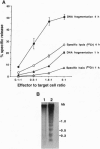Abstract
We have investigated the ability of human immunodeficiency virus (HIV)-infected cells to kill uninfected CD4+ lymphocytes. Infected peripheral blood mononuclear cells were cocultured with autologous 51Cr-labeled uninfected cells. Rapid death of the normal CD4-expressing target population was observed following a brief incubation. Death of blood CD4+ lymphocytes occurred before syncytium formation could be detected or productive viral infection established in the normal target cells. Cytolysis could not be induced by free virus, was dependent on gp120-CD4 binding, and occurred in resting, as well as activated, lymphocytes. CD8+ cells were not involved in this phenomenon, since HIV-infected CEMT4 cells (CD4+, CD8- cells) mediated the cytolysis of uninfected targets. Reciprocal isotope-labeling experiments demonstrated that infected CEMT4 cells did not die in parallel with their targets. The uninfected target cells manifested DNA fragmentation, followed by the release of the 51Cr label. Thus, in HIV patients, infected lymphocytes may cause the depletion of the much larger population of uninfected CD4+ cells without actually infecting them, by triggering an apoptotic death.
Full text
PDF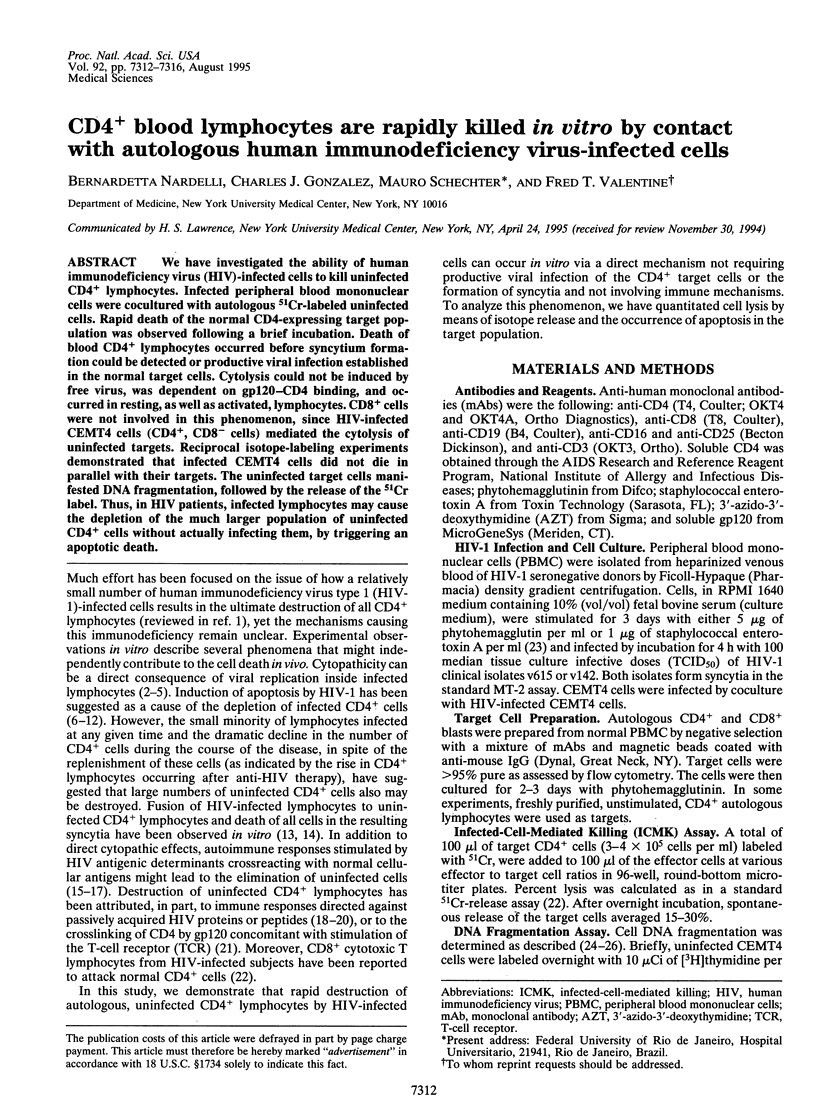
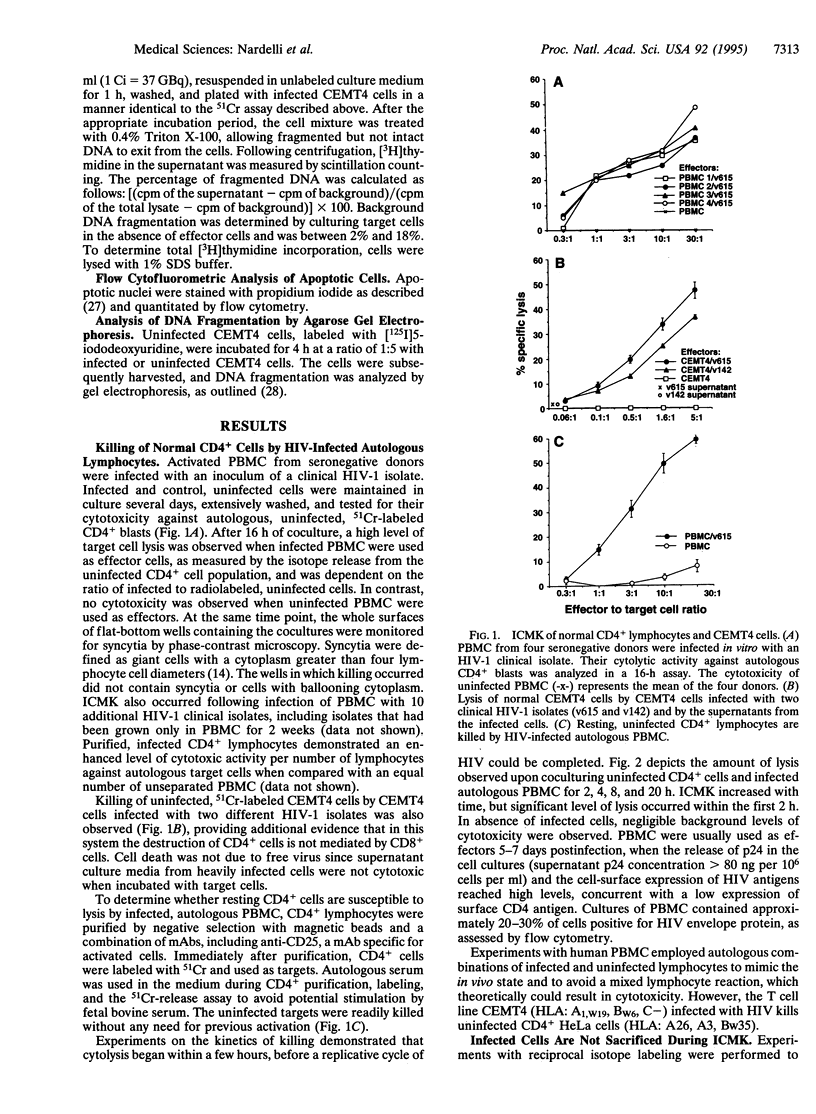
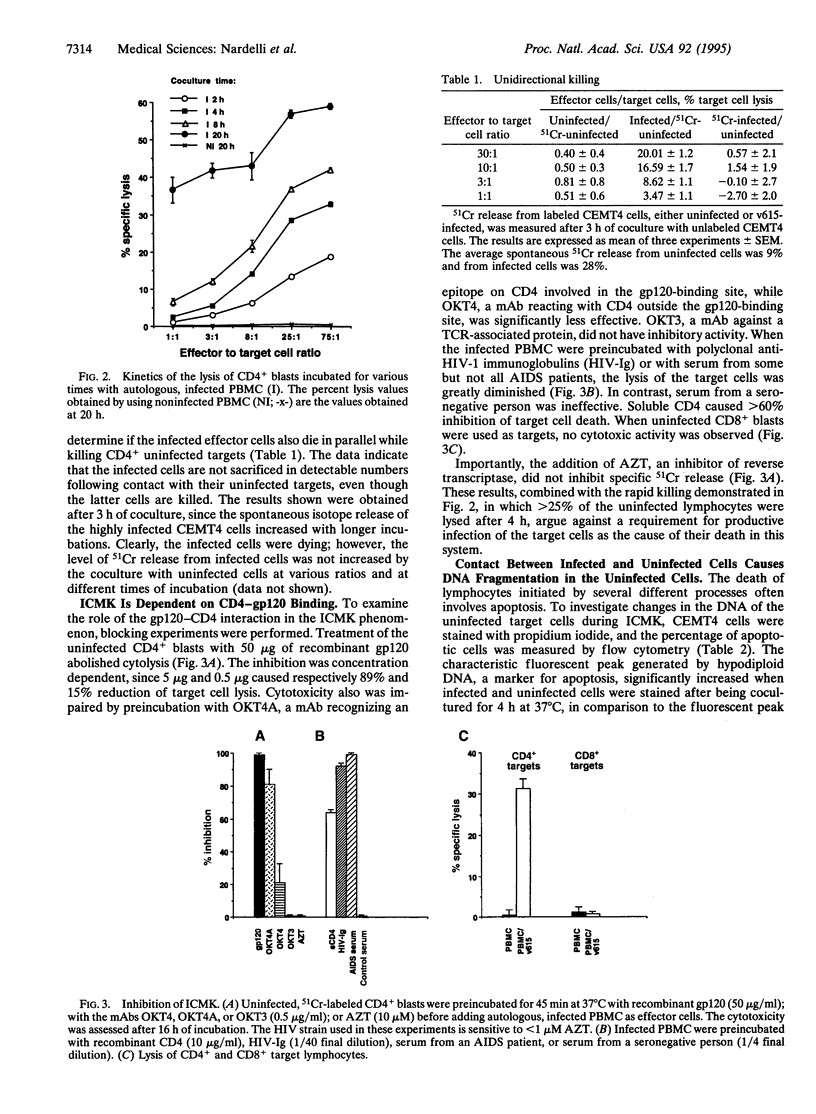
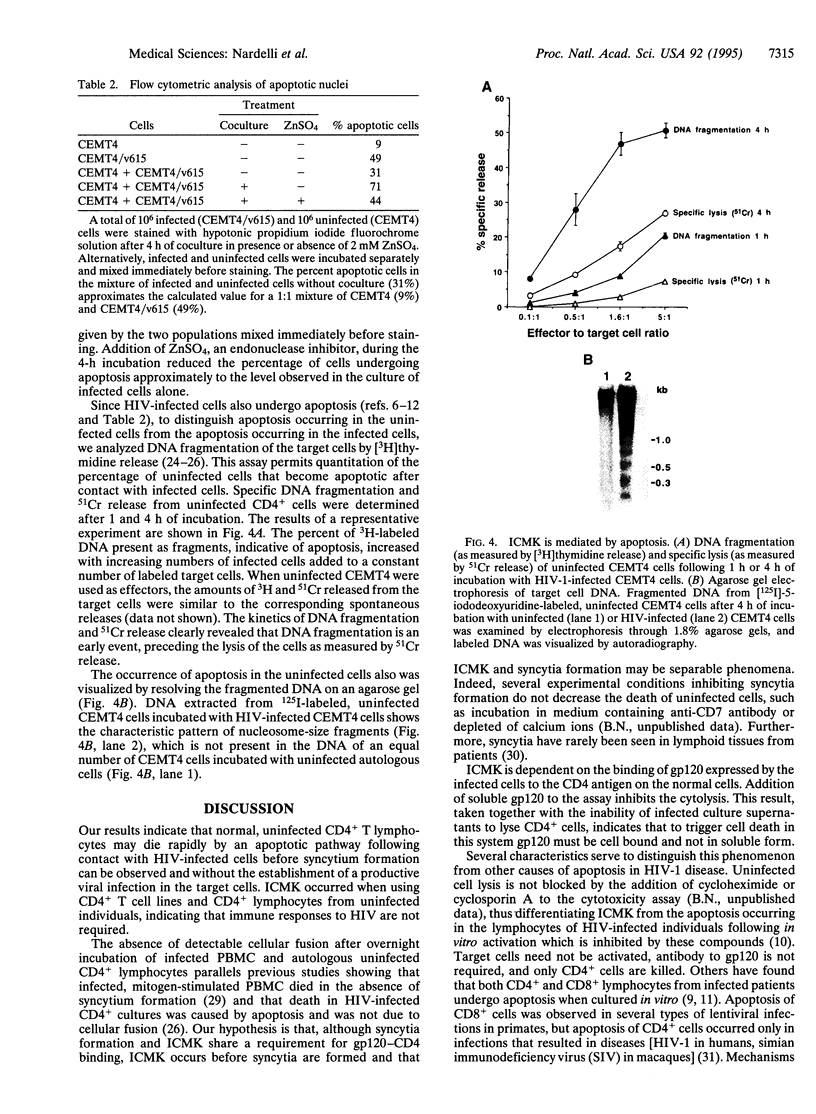
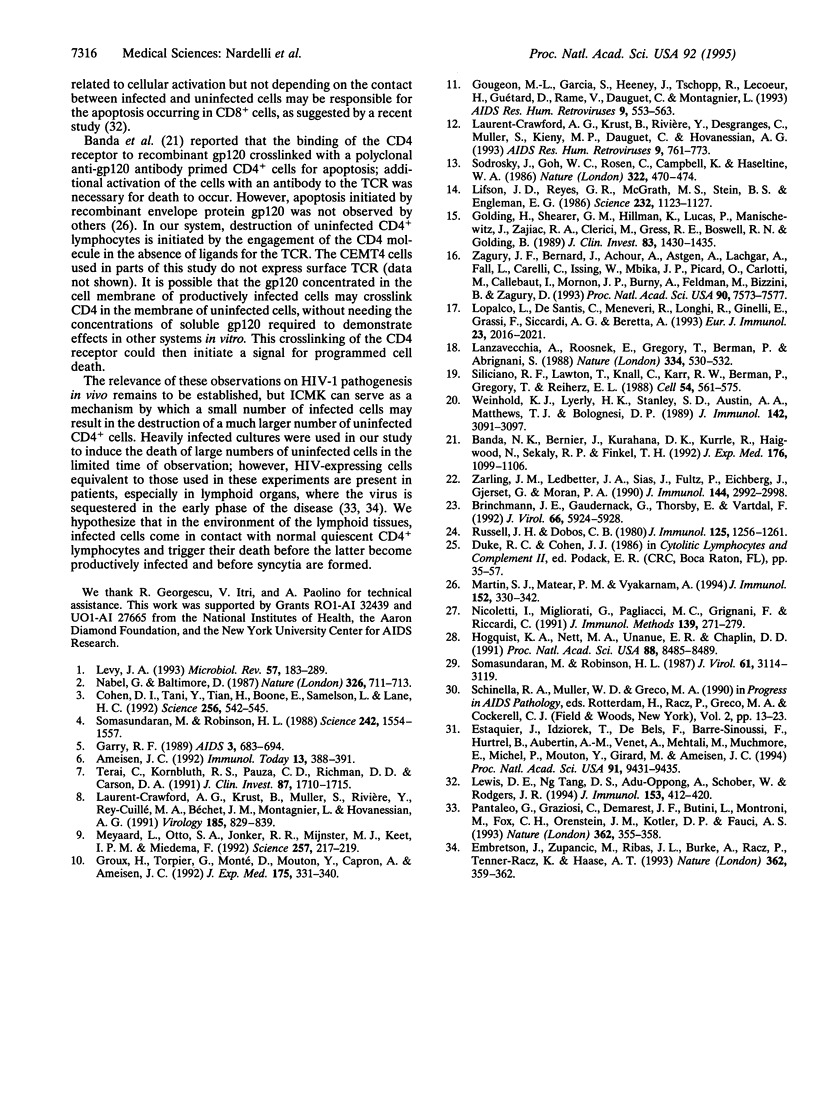
Images in this article
Selected References
These references are in PubMed. This may not be the complete list of references from this article.
- Ameisen J. C. Programmed cell death and AIDS: from hypothesis to experiment. Immunol Today. 1992 Oct;13(10):388–391. doi: 10.1016/0167-5699(92)90086-M. [DOI] [PubMed] [Google Scholar]
- Banda N. K., Bernier J., Kurahara D. K., Kurrle R., Haigwood N., Sekaly R. P., Finkel T. H. Crosslinking CD4 by human immunodeficiency virus gp120 primes T cells for activation-induced apoptosis. J Exp Med. 1992 Oct 1;176(4):1099–1106. doi: 10.1084/jem.176.4.1099. [DOI] [PMC free article] [PubMed] [Google Scholar]
- Brinchmann J. E., Gaudernack G., Thorsby E., Vartdal F. Staphylococcal exotoxin superantigens induce human immunodeficiency virus type 1 expression in naturally infected CD4+ T cells. J Virol. 1992 Oct;66(10):5924–5928. doi: 10.1128/jvi.66.10.5924-5928.1992. [DOI] [PMC free article] [PubMed] [Google Scholar]
- Cohen D. I., Tani Y., Tian H., Boone E., Samelson L. E., Lane H. C. Participation of tyrosine phosphorylation in the cytopathic effect of human immunodeficiency virus-1. Science. 1992 Apr 24;256(5056):542–545. doi: 10.1126/science.1570514. [DOI] [PubMed] [Google Scholar]
- Embretson J., Zupancic M., Ribas J. L., Burke A., Racz P., Tenner-Racz K., Haase A. T. Massive covert infection of helper T lymphocytes and macrophages by HIV during the incubation period of AIDS. Nature. 1993 Mar 25;362(6418):359–362. doi: 10.1038/362359a0. [DOI] [PubMed] [Google Scholar]
- Estaquier J., Idziorek T., de Bels F., Barré-Sinoussi F., Hurtrel B., Aubertin A. M., Venet A., Mehtali M., Muchmore E., Michel P. Programmed cell death and AIDS: significance of T-cell apoptosis in pathogenic and nonpathogenic primate lentiviral infections. Proc Natl Acad Sci U S A. 1994 Sep 27;91(20):9431–9435. doi: 10.1073/pnas.91.20.9431. [DOI] [PMC free article] [PubMed] [Google Scholar]
- Garry R. F. Potential mechanisms for the cytopathic properties of HIV. AIDS. 1989 Nov;3(11):683–694. doi: 10.1097/00002030-198911000-00001. [DOI] [PubMed] [Google Scholar]
- Golding H., Shearer G. M., Hillman K., Lucas P., Manischewitz J., Zajac R. A., Clerici M., Gress R. E., Boswell R. N., Golding B. Common epitope in human immunodeficiency virus (HIV) I-GP41 and HLA class II elicits immunosuppressive autoantibodies capable of contributing to immune dysfunction in HIV I-infected individuals. J Clin Invest. 1989 Apr;83(4):1430–1435. doi: 10.1172/JCI114034. [DOI] [PMC free article] [PubMed] [Google Scholar]
- Gougeon M. L., Garcia S., Heeney J., Tschopp R., Lecoeur H., Guetard D., Rame V., Dauguet C., Montagnier L. Programmed cell death in AIDS-related HIV and SIV infections. AIDS Res Hum Retroviruses. 1993 Jun;9(6):553–563. doi: 10.1089/aid.1993.9.553. [DOI] [PubMed] [Google Scholar]
- Groux H., Torpier G., Monté D., Mouton Y., Capron A., Ameisen J. C. Activation-induced death by apoptosis in CD4+ T cells from human immunodeficiency virus-infected asymptomatic individuals. J Exp Med. 1992 Feb 1;175(2):331–340. doi: 10.1084/jem.175.2.331. [DOI] [PMC free article] [PubMed] [Google Scholar]
- Hogquist K. A., Nett M. A., Unanue E. R., Chaplin D. D. Interleukin 1 is processed and released during apoptosis. Proc Natl Acad Sci U S A. 1991 Oct 1;88(19):8485–8489. doi: 10.1073/pnas.88.19.8485. [DOI] [PMC free article] [PubMed] [Google Scholar]
- Lanzavecchia A., Roosnek E., Gregory T., Berman P., Abrignani S. T cells can present antigens such as HIV gp120 targeted to their own surface molecules. Nature. 1988 Aug 11;334(6182):530–532. doi: 10.1038/334530a0. [DOI] [PubMed] [Google Scholar]
- Laurent-Crawford A. G., Krust B., Muller S., Rivière Y., Rey-Cuillé M. A., Béchet J. M., Montagnier L., Hovanessian A. G. The cytopathic effect of HIV is associated with apoptosis. Virology. 1991 Dec;185(2):829–839. doi: 10.1016/0042-6822(91)90554-o. [DOI] [PubMed] [Google Scholar]
- Laurent-Crawford A. G., Krust B., Rivière Y., Desgranges C., Muller S., Kieny M. P., Dauguet C., Hovanessian A. G. Membrane expression of HIV envelope glycoproteins triggers apoptosis in CD4 cells. AIDS Res Hum Retroviruses. 1993 Aug;9(8):761–773. doi: 10.1089/aid.1993.9.761. [DOI] [PubMed] [Google Scholar]
- Levy J. A. Pathogenesis of human immunodeficiency virus infection. Microbiol Rev. 1993 Mar;57(1):183–289. doi: 10.1128/mr.57.1.183-289.1993. [DOI] [PMC free article] [PubMed] [Google Scholar]
- Lewis D. E., Tang D. S., Adu-Oppong A., Schober W., Rodgers J. R. Anergy and apoptosis in CD8+ T cells from HIV-infected persons. J Immunol. 1994 Jul 1;153(1):412–420. [PubMed] [Google Scholar]
- Lifson J. D., Reyes G. R., McGrath M. S., Stein B. S., Engleman E. G. AIDS retrovirus induced cytopathology: giant cell formation and involvement of CD4 antigen. Science. 1986 May 30;232(4754):1123–1127. doi: 10.1126/science.3010463. [DOI] [PubMed] [Google Scholar]
- Lopalco L., De Santis C., Meneveri R., Longhi R., Ginelli E., Grassi F., Siccardi A. G., Beretta A. Human immunodeficiency virus type 1 gp120 C5 region mimics the HLA class I alpha 1 peptide-binding domain. Eur J Immunol. 1993 Aug;23(8):2016–2021. doi: 10.1002/eji.1830230844. [DOI] [PubMed] [Google Scholar]
- Martin S. J., Matear P. M., Vyakarnam A. HIV-1 infection of human CD4+ T cells in vitro. Differential induction of apoptosis in these cells. J Immunol. 1994 Jan 1;152(1):330–342. [PubMed] [Google Scholar]
- Meyaard L., Otto S. A., Jonker R. R., Mijnster M. J., Keet R. P., Miedema F. Programmed death of T cells in HIV-1 infection. Science. 1992 Jul 10;257(5067):217–219. doi: 10.1126/science.1352911. [DOI] [PubMed] [Google Scholar]
- Nabel G., Baltimore D. An inducible transcription factor activates expression of human immunodeficiency virus in T cells. Nature. 1987 Apr 16;326(6114):711–713. doi: 10.1038/326711a0. [DOI] [PubMed] [Google Scholar]
- Nicoletti I., Migliorati G., Pagliacci M. C., Grignani F., Riccardi C. A rapid and simple method for measuring thymocyte apoptosis by propidium iodide staining and flow cytometry. J Immunol Methods. 1991 Jun 3;139(2):271–279. doi: 10.1016/0022-1759(91)90198-o. [DOI] [PubMed] [Google Scholar]
- Pantaleo G., Graziosi C., Demarest J. F., Butini L., Montroni M., Fox C. H., Orenstein J. M., Kotler D. P., Fauci A. S. HIV infection is active and progressive in lymphoid tissue during the clinically latent stage of disease. Nature. 1993 Mar 25;362(6418):355–358. doi: 10.1038/362355a0. [DOI] [PubMed] [Google Scholar]
- Russell J. H., Dobos C. B. Mechanisms of immune lysis. II. CTL-induced nuclear disintegration of the target begins within minutes of cell contact. J Immunol. 1980 Sep;125(3):1256–1261. [PubMed] [Google Scholar]
- Siliciano R. F., Lawton T., Knall C., Karr R. W., Berman P., Gregory T., Reinherz E. L. Analysis of host-virus interactions in AIDS with anti-gp120 T cell clones: effect of HIV sequence variation and a mechanism for CD4+ cell depletion. Cell. 1988 Aug 12;54(4):561–575. doi: 10.1016/0092-8674(88)90078-5. [DOI] [PubMed] [Google Scholar]
- Sodroski J., Goh W. C., Rosen C., Campbell K., Haseltine W. A. Role of the HTLV-III/LAV envelope in syncytium formation and cytopathicity. 1986 Jul 31-Aug 6Nature. 322(6078):470–474. doi: 10.1038/322470a0. [DOI] [PubMed] [Google Scholar]
- Somasundaran M., Robinson H. L. A major mechanism of human immunodeficiency virus-induced cell killing does not involve cell fusion. J Virol. 1987 Oct;61(10):3114–3119. doi: 10.1128/jvi.61.10.3114-3119.1987. [DOI] [PMC free article] [PubMed] [Google Scholar]
- Somasundaran M., Robinson H. L. Unexpectedly high levels of HIV-1 RNA and protein synthesis in a cytocidal infection. Science. 1988 Dec 16;242(4885):1554–1557. doi: 10.1126/science.3201245. [DOI] [PubMed] [Google Scholar]
- Terai C., Kornbluth R. S., Pauza C. D., Richman D. D., Carson D. A. Apoptosis as a mechanism of cell death in cultured T lymphoblasts acutely infected with HIV-1. J Clin Invest. 1991 May;87(5):1710–1715. doi: 10.1172/JCI115188. [DOI] [PMC free article] [PubMed] [Google Scholar]
- Weinhold K. J., Lyerly H. K., Stanley S. D., Austin A. A., Matthews T. J., Bolognesi D. P. HIV-1 GP120-mediated immune suppression and lymphocyte destruction in the absence of viral infection. J Immunol. 1989 May 1;142(9):3091–3097. [PubMed] [Google Scholar]
- Zagury J. F., Bernard J., Achour A., Astgen A., Lachgar A., Fall L., Carelli C., Issing W., Mbika J. P., Picard O. Identification of CD4 and major histocompatibility complex functional peptide sites and their homology with oligopeptides from human immunodeficiency virus type 1 glycoprotein gp120: role in AIDS pathogenesis. Proc Natl Acad Sci U S A. 1993 Aug 15;90(16):7573–7577. doi: 10.1073/pnas.90.16.7573. [DOI] [PMC free article] [PubMed] [Google Scholar]
- Zarling J. M., Ledbetter J. A., Sias J., Fultz P., Eichberg J., Gjerset G., Moran P. A. HIV-infected humans, but not chimpanzees, have circulating cytotoxic T lymphocytes that lyse uninfected CD4+ cells. J Immunol. 1990 Apr 15;144(8):2992–2998. [PubMed] [Google Scholar]



